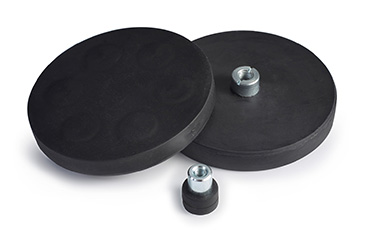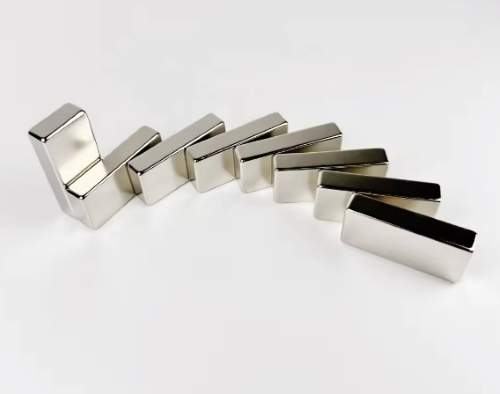What are the Coatings for Rare Earth Magnets?
The painting or coating of magnets isn't necessarily to improve the properties of the magnets per se. Coatings are often used to hide or disguise magnets, but most importantly, they serve protective functions. Neodymium magnets, for instance, are commonly used to display artwork in homes and art galleries. Coating the magnet with the same color as the artwork makes the magnet stand out less than a shiny silver magnet. Most magnetic materials can be coated, including permanent magnets and temporary magnets. Also, the coatings or magnetic primers do not impact the magnetic properties of the magnet. But with a typical nickel coating over a rare-earth magnet like a neodymium magnet, the magnet can be protected from corrosive elements in the atmosphere. Other coatings that can also be used for rare earth magnets include gold, rubber, and polytetrafluoroethylene (PTFE).
What is a Magnet Coating?
Magnet coatings (also known as magnetic paints or primers) are used to reduce the susceptibility of magnets to corrosion and other negative environmental factors that might degrade the magnets. Neodymium, ferrite, and samarium-cobalt magnets, for example, can be quite brittle, so the coatings offer the magnets extra durability. Note that coatings do not impact the core magnetic properties of the magnets. The coating is similar to regular paint, except that tiny particles of iron dust are mixed in. Rare-earth magnetic coating materials include nickel, copper, chromium, gold, black zinc, epoxy resin, and several others.
Why & When do Magnets Need Coatings?
As stated above, magnet coatings are used to protect the neodymium magnets. Neodymium easily reacts to oxygen and oxidizes quickly if untreated. To prevent this from happening, neodymium magnets are covered with a protective coating. Note that the coating is pretty faint or thin, and as such, it doesn't have any impact on the adhesive force of the magnet itself. Manufacturers use such coatings to preserve the magnets, as well as add some cosmetic effects to the magnets.

Rubber Coated Magnets
Types of Magnet Coatings
There are many different magnet coatings for magnets, but the appropriate coating will depend on the parameters of the application, as well as many other factors like environment, temperature, durability, and government regulations, such as FDA-approved coatings. Here are some magnet coatings available on the market:
Nickel
Nickel is the most common coating on magnets. It typically comes in 3 layers, which are nickel-copper-nickel. It protects rare-earth magnets from chipping and corrosion in ambient air. However, it does not serve as a protective coating from humidity, water, or salt water. Nickel coating is also a decorative finish and has a shiny metallic gray finish. It has a thickness of 15-25 um and works at approximately 200°C. The main areas of application of nickel magnet coating are motors, medical devices, generators, pumps, sensors, automotive, etc., and several other industries.
Gold
Gold is used as an FDA-approved medical coating for in-body use, it is used as an undercoating of Ni-Cu-Ni. Like nickel coating, it helps to protect the magnet from corrosion in ambient air but also offers mild protection from humidity, water, or salt water. The thickness of the gold is very thin (approximately 0.1- 1um), so its performance in salt spray tests may be poor, as most gold coating is intended to be thin. Its max working temperature is approximately 200°C.
Zinc
Zinc coating offers good adhesion when glued with epoxy onto the steel. It is used for the protection of the magnet from corrosion in surrounding air and it offers mild protection from humidity, water, or salt water. However, it is not a fitting choice if the magnet is in a moisture environment. It has a thin thickness of 4-10 um and a maximum working temperature of approximately 120°C. Zinc coating is mostly used in low-temperature applications and where a little protective barrier is needed.
Epoxy
Unlike gold, zinc, and nickel, epoxy magnet coating works as an excellent barrier to salt, ambient air, and water or humidity. But it is slightly costlier than the first three alternatives. Although it can scratch easily and has a maximum working temperature of 15-30 um, it has very good adhesion to steel with magnet-rated glue. Epoxy coating is mainly used in the marine, motor, sensors, automotive, and consumer products industries.
Injection Molding / Plastic
This coating requires molds and tooling. It is an excellent protective covering for rare-earth magnets against breakage, impact, and corrosion. It can be used for coating medium-large magnets. Note that small magnets cannot be coated in plastic. They serve as a good protective coating against salt water, humidity, or water. The color of the plastic can be tinted to almost any color. The common thickness of the coating is between 1 and 2 mm. The maximum working temperature will typically be determined by the type of ABS plastic selected. It is used for medical, educational, consumer products, etc.
Teflon (Molded PTFE)
Teflon coating also requires molds and tooling, and that can determine its cost. However, it is an excellent protection for a magnet against breakage, impact, and corrosion. The molding is available for magnets that are medium to larger but does not work for small magnets. It is good for protecting rare-earth magnets from humidity, fluids, and autoClave. The common thickness is between 1.5 and 3 mm with a maximum working temperature of approximately 2500°C. Teflon coating is predominantly used in the medical and food industries.
Conclusion
Magnet coating serves both aesthetic and protective purposes on rare-earth magnets; they do not change the magnetic properties of the magnets but provide protective coatings for extra durability. Common coatings include nickel, zinc, gold, and epoxy. Others are black nickel, perylene, silver, chrome, copper, rubber, rhodium, spray PTFE (Teflon), and titanium nitride (TiN). Thank you for reading our article and we hope it can help you to have a better understanding of magnet coating.
If you want to learn more about magnets, we would like to advise you to visit Stanford Magnets for more information. As a leading magnet supplier across the world, Stanford Magnets has been involved in the R&D, manufacturing, and sales of magnets since the 1990s. It provides customers with high-quality permanent magnets like SmCo magnets, neodymium magnets, AlNiCo magnets, and ferrite magnets (ceramic magnets) at a very competitive price.















